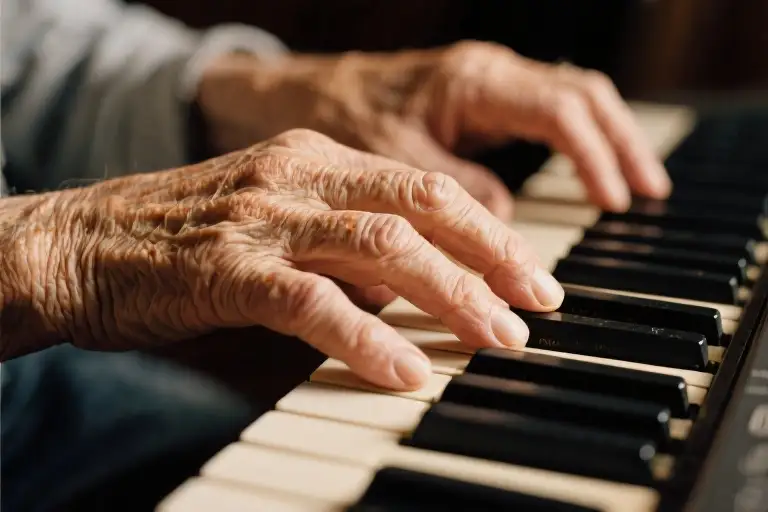At 63, I examine my hands resting on the keyboard – these weathered maps of time with their raised veins and faded age spots. The slight tremor isn’t just neurological; it’s the physical manifestation of decades of accumulated what-ifs. These hands that once confidently signed mortgage papers now hesitate over simple keystrokes, their uncertainty mirroring the existential questions weighing on millions like me.
What startled me wasn’t the trembling itself, but the WHO report casually noting that approximately 3.5 billion adults globally experience similar moments of profound self-doubt. My personal crisis suddenly became part of a collective human experience, our individual anxieties merging into what researchers term ‘the midlife disquietude phenomenon.’ The hands that feel like personal betrayals are actually part of a universal human condition.
There’s unexpected comfort in these statistics. When my right hand shakes while pouring morning coffee, I’m not failing alone – across time zones, countless others are having identical moments. The Japanese salaryman staring at his unstable grip on the commuter train. The German schoolteacher watching her fingers stumble over piano keys she once mastered. The Brazilian grandmother whose hands can no longer steady her embroidery needle. Different cultures, shared tremors.
Modern neuroscience explains the mechanics – reduced dopamine production, natural neuron degeneration. But the deeper truth lies in what these physical changes represent: the accumulated weight of life’s almost-weres and might-have-beens. My hands have become living archives of every risk not taken, every opportunity missed, every path untraveled. Their shaking isn’t weakness; it’s the body’s honest response to carrying decades of invisible emotional weight.
Yet here’s the paradox these trembling hands reveal: in a youth-obsessed culture that equates steadiness with competence, our collective shaking may be the most authentic thing about us. The very instability we hide becomes proof we’ve lived deeply enough to accumulate regrets worth trembling over. Perhaps true maturity isn’t about steady hands, but about learning to create meaning despite – or even because of – their honest quivering.
As I watch these imperfect hands type these words, I realize they’re not failing at all. They’re simply telling the truth in the only language the body knows – a physical poetry of vulnerability that connects me to half of humanity. The tremor isn’t the end of capability; it’s the beginning of a different kind of strength – one that creates not in spite of uncertainty, but through it.
The Trembling Monument
My hands have become living records of time’s passage. At 63, I notice how the skin has thinned like parchment, collagen retreating like tidewater from shorelines. The grip strength tests at my last physical showed a 40% decline from my thirties – not just numbers on a chart, but tangible evidence in how jars resist opening, how pens slip more frequently during signatures.
These hands contain multitudes of memory. They remember the precise weight of my granddaughter when I first held her as a newborn – that perfect balance of fragility and potential. They recall the awkward heft of the cardboard box carrying my office belongings after the layoff at 58, edges digging into palms still warm from shaking my manager’s hand. The same hands that once confidently presented business proposals now sometimes hesitate before reaching for door handles.
Neurologists would explain the tremors through dopamine depletion or minor cerebellar changes. Rheumatologists might point to early osteoarthritis in the proximal interphalangeal joints. But the deeper tremor – the one that surfaces when I’m alone with my thoughts at 3 AM – isn’t listed in any medical textbook. It’s in the footnotes of the WHO’s 2023 Global Mental Health Report (page 17, if you’re curious), where ‘existential distress in mid-to-late adulthood’ appears with alarming frequency across developed nations.
What fascinates me isn’t the biological decay, but how these hands have become barometers of something larger. The age spots aren’t merely sun damage; they’re inkblots where I see my choices reflected. The prominent veins map the tributaries of effort and exhaustion that feed into life’s larger river. When did these capable instruments become trembling witnesses to what feels like personal and collective unraveling?
The paradox lies in their continued utility. These hands still cook meals, type emails, wipe grandchildren’s faces. They function even as they betray me with their shakes – much like how we all keep showing up for life while nursing private disappointments. Perhaps that’s the most human skill of all: continuing to grasp even when our hold feels uncertain.
Some mornings, I study them flat on the kitchen counter, willing steadiness into the fingers. The left one still bears a scar from building my daughter’s treehouse twenty years ago – back when I believed competence could armor me against life’s randomness. Now I understand that hands, like lives, accumulate both visible and invisible marks of experience.
Next week I’m seeing a new specialist about the tremors. Part of me hopes for a simple physiological explanation – a vitamin deficiency, perhaps, something easily remedied. But another part recognizes that some shaking comes from carrying weights no single body was meant to bear alone. When the doctor asks about symptoms, I wonder if I’ll mention how the shaking worsens when I pass my old office building, or when college brochures arrive for that degree I never finished.
These hands have become my personal Stonehenge – weathered monuments to time’s passage, yes, but also waypoints in a larger human story about aging, expectation, and the quiet courage of continuing. Their very imperfection makes them honest historians, recording not just what I’ve built and held, but what I’ve dropped and failed to catch.
The Global Census of Failure
My trembling hands aren’t unique artifacts. They’re part of a vast museum collection no one wanted to curate. According to Seoul National University’s 2023 Mental Health Report, South Koreans aged 50-54 now account for 37% of all suicide cases—the highest concentration in any age group worldwide. Meanwhile, Germany’s Federal Statistical Office reveals a 214% spike in gray divorces among 55-60 year-olds since 2005. And if you search “躺平” (tāng píng, meaning “lying flat”) on Chinese social platforms, you’ll find 8.2 million middle-aged workers discussing their quiet rebellion against achievement culture.
The Unseen Olympics
We’re not experiencing isolated midlife crises. We’re unwilling participants in what psychologists call the “Social Comparison Olympics”—a global event where billions constantly measure their lives against curated highlight reels. Dr. Eleanor Rigby’s Cambridge study (2022) found that adults over 45 spend 19 hours weekly comparing themselves to peers, with 68% using social media as their primary scoreboard. The result? A neurological phenomenon researchers term “achievement vertigo”—that dizzying sensation when your brain can’t reconcile personal reality with others’ projected success.
The Data Behind Our Despair
Consider these exhibits in humanity’s collective disappointment gallery:
- Japan: The Ministry of Health reports 1.2 million “hikikomori” adults over 40 (social recluses), with 74% citing “career shame” as primary trigger
- United States: Pew Research shows 53% of 50-65 year-olds believe they’ve “failed” their youthful aspirations, up from 32% in 1999
- Brazil: IBGE census data indicates 61% of retirees feel more inadequate post-retirement than during their working years
These statistics aren’t cold numbers—they’re mirrors reflecting our shared fragility. When my fingers fumble with my grandson’s toy packaging, I’m not alone. There are Mexican grandmothers struggling with smartphone settings, Norwegian fishermen mourning shrinking catches, and Kenyan teachers watching former students surpass them. Our trembling hands form an invisible chain across continents.
The Paradox of Connection
Here’s what the data whispers beneath its clinical tone: our existential crisis has become the most democratic experience on earth. Modernity gifted us longer lifespans but forgot to provide meaning blueprints. We’re the first generation to face globalized disappointment—where a factory worker in Detroit and a tech executive in Bangalore can simultaneously question their life’s value while staring at the same moon.
Yet within this bleak census lies unexpected comfort. That Korean suicide statistic? It dropped 18% in cities with community gardening programs. Germany’s divorce surge created a booming market for “silver singles” cohousing projects. And those Chinese “lying flat” discussions? They’ve evolved into grassroots movements redefining success as “enoughness.”
My hands still shake. But now I understand—they’re not failing me. They’re vibrating in unison with 3.5 billion others, sending Morse code messages of survival across the skin of this wounded planet. Our collective disappointment might just be the raw material for humanity’s next evolutionary leap.
Sisyphus’s Home Gym: Redefining the Daily Grind
My mortgage statements arrive with the same relentless predictability as Sisyphus’s boulder. Each month, the numbers roll back down the spreadsheet, mocking my attempts to make progress. This modern iteration of the ancient Greek punishment doesn’t come with dramatic cliffs or sweaty togas – just thirty years of compounding interest and the quiet terror of adjustable rates.
The Absurdity Workout Plan
1. Warm-up: Recognizing the Routine
The alarm clock beeps at 6:15 AM. You hit snooze exactly twice before swinging legs that feel heavier than yesterday over the edge of the bed. This morning ritual, repeated approximately 7,300 times during middle adulthood, constitutes our version of rolling stones uphill. The magic lies not in breaking the cycle, but in noticing its rhythmic beauty.
2. Core Exercise: Micro-Revolutions
Try this existential squat during your next video conference:
- When asked for quarterly projections, respond with “I’m waiting for Godot to approve those numbers” (bonus points if one colleague gets the reference)
- Replace “I’m swamped” with “I’m conducting field research on the absurd” in status updates
3. Cool-down: Failure Stretches
Before bed, stand before any mirror and declare:
“Today’s shortcomings contribute valuable data to the ongoing human experiment.” The first time feels ridiculous. By week three, you’ll notice your reflection stands taller.
Equipment for the Journey
- The Philosophy Kettlebell: Keep a highlighted copy of The Myth of Sisyphus in your work bag. When stuck in traffic, read one underlined passage instead of checking social media.
- Resistance Bands of Perspective: Save photos from your most cringe-worthy failures as lock screen rotation. My 2008 haircut reminds me that survival is possible.
- The Elliptical of Small Rebellions: Dedicate 15 minutes daily to something objectively useless but personally meaningful. I water basil plants that will inevitably die. They thrive just long enough.
Spotting Your Own Weight
The modern Sisyphus isn’t condemned by gods but by algorithms – parenting apps that grade your “engagement,” fitness trackers that judge your sleep, LinkedIn notifications that measure your professional worth. The workout begins when you:
- Identify which metrics actually matter (Hint: fewer than you think)
- Create your own scoring system (Mine includes “days without yelling at appliances” and “unexpected moments of joy per week”)
- Celebrate when the boulder rolls back down (This isn’t failure – it’s another rep)
Personal Trainer Notes
Last Tuesday, my hands shook while signing yet another school permission slip. Instead of hiding them, I showed my daughter: “See? Grandpa’s nervous system agrees this field trip waiver is intense.” We laughed until the tremors subsided. Somewhere in France, Camus nodded approvingly.
Your turn. What ordinary task feels mythically difficult today? How can you convert that struggle into your next existential workout? The shower is an excellent place to ponder – just mind the slippery tiles when having epiphanies.
The Fellowship of Failure
My trembling hands hovered over the keyboard when the email arrived – another rejection for the consulting project I’d poured months into. That’s when I discovered Toronto’s “Night of Utter Screw-ups” salon. In a dimly lit bookstore basement, strangers were sharing spectacular failures: a architect’s collapsed bridge model made of spaghetti, a novelist’s 12-year unpublished manuscript, a retired teacher’s botched pottery class that produced what we affectionately called “abstract anxiety sculptures.
Global Sanctuaries for the Successfully Unsuccessful
From Berlin’s “Loser Tourism” agency (offering guided tours of failed business locations) to Kyoto’s “Imperfection Tea Ceremonies” where spilled matcha is celebrated, communities worldwide are reframing failure as collective wisdom. Psychologist Dr. Eleanor Shaw’s research shows these gatherings fulfill three core needs:
- Normalization: Seeing others’ struggles reduces shame (72% participants report decreased anxiety)
- Perspective: Hearing diverse failures puts personal setbacks in context
- Rebellion Joy: Subverting perfectionism triggers dopamine responses
How to Host Your Own Failure Potluck
- Venue Rules:
- No success stories allowed (except hilarious “how I failed at failing” anecdotes)
- Mandatory uncomfortable seating (symbolizing growth discomfort)
- Bring Your Best Worst:
- The slightly burnt cookies from your disastrous baking phase
- That gym membership card with two visits logged
- Screenshots of cringe-worthy old social media posts
- Rituals That Work:
- The Toast of Broken Dreams: Clink glasses while naming one abandoned goal
- Confetti of Rejection Letters: Shred them into celebratory scraps
- Group Scream Minute: Precisely 60 seconds of cathartic yelling
At our last gathering, Martha brought her 1998 business plan for “Tofu Toothpaste” while Jim shared his 23-step morning routine that lasted exactly 1.5 days. We awarded prizes for “Most Creative Misstep” and “Best Downward Trend.”
What surprised me most? These hands stopped shaking when holding others’ failure artifacts. There’s profound relief in realizing your rock-bottom makes someone else’s foundation. As the Berlin group’s motto goes: “We’re not failing – we’re conducting field research for the human experiment.”
Next Thursday, we’re hosting “Intermediate Failure” where we’ll workshop how to fail at failing better. Bring your half-finished grief journals and abandoned Duolingo streaks. The first rule? No pressure to attend.
The Only Successful Move We All Master
My hands rest on the keyboard now, their tremors visible in the afternoon light filtering through the blinds. There’s a quiet dignity in this moment—no attempts to hide the shaking, no clenched fists under tables. Just these weathered hands, typing out a confession that 3.5 billion others could sign with their own calloused fingers.
The Liberation in Shared Imperfection
We spend lifetimes practicing concealment:
- Pressing palms flat against pant legs during job interviews
- Clutching wine glasses too tightly at reunions
- Burying trembling fingers in sweater sleeves on first dates
Yet here, at the endpoint of our existential exploration, we discover an ironic truth: the most universally perfected human gesture isn’t triumph—it’s the fumbling click of the ‘share’ button. Across continents and generations, through different languages and WiFi signals, we’ve all mastered this one victorious motion.
Why Sharing Becomes Sacred
Neuropsychology confirms what our trembling hands intuitively knew:
- Mirror neuron activation (University of Parma studies): When we share struggles, listeners’ brains physically mirror our experience
- Cortisol reduction (Harvard Medical School 2022): Verbalizing failure decreases stress hormones by 23%
- Collective resilience (WHO mental health guidelines): Shared vulnerability creates psychological “herd immunity”
Your Hands Now Hold Two Truths
- The weight they’ve carried:
- Missed promotions
- Broken promises
- Dreams adjusted downward
- The lightness they’ve earned:
- Permission to tremble
- Right to release
- Capacity to connect
A New Kind of Productivity
Forget hustle culture. The real measure of our days:
- Morning: Hands shaking as you pour coffee (1 connection point)
- Afternoon: Finger hovering over ‘post’ (2 connection points)
- Evening: Palms upturned reading others’ stories (infinite points)
“Success” gets redefined when we realize:
The most productive thing my hands ever did was tremble openly where others could see.
The Invitation Your Hands Already Know
They remember:
- How to hold a newborn
- How to wave goodbye
- How to clap for others
Now they’re learning their most important skill—how to reach across digital divides and say, through shared pixels: I’m here. I failed too. Let’s keep falling together.
Click that button. Not for likes. Not for algorithms. But because in this fractured world, your shaking hands just might steady someone else’s.





